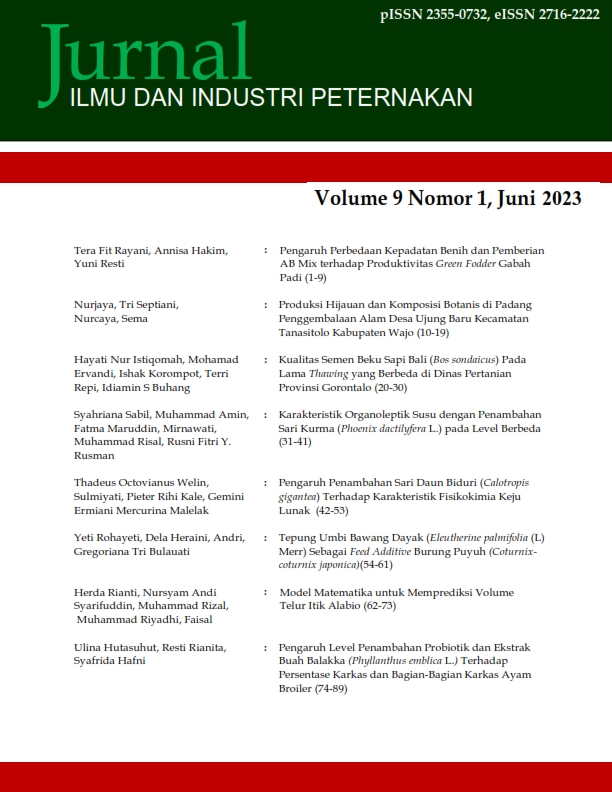Tepung Umbi Bawang Dayak (Eleutherine palmifolia (L) Merr) Sebagai Feed Additive Burung Puyuh (Coturnix-coturnix japonica)
Abstract
Quail is a bird that has a medium body size and is relatively unable to fly like other birds. Increasing the quail population must be balanced with good maintenance management, especially during the growth phase. An alternative to improve growth performance is to provide feed additives in the ration, one of which is dayak onion bulbs. The purpose of this study was to determine the effect of giving dayak onion flour (Eleutherine palmifolia, (L) Merr) as a feed additive on the growth performance of quail (Coturnix-coturnix japonica). This study used a completely randomized design (CRD) consisting of 5 treatments and 5 replications, each treatment consisting of 7 quails so that the total number of quails was 175. The treatments used in this study were commercial feed (PK) and dayak onion flour (TUBD) consisting of P0 (100% PK), P1 (100% PK + 1% TUBD), P2 (100% PK + 2% TUBD ), P3 (100% PK + 3% TUBD), and P4 (100% PK + 4% TUBD). Parameters observed were feed consumption, body weight gain, feed conversion, weight of first laying eggs. The results of the analysis of variance (Anova) showed that the administration of dayak onion bulb flour had no significant effect (P>0.05) on the growth performance of quail including feed consumption, body weight gain, feed conversion, weight of first laying brood. The results showed that the highest feed consumption occurred at P0 (100% PK) = 115.90 gram/head/week; highest body weight gain occurred at P2 (100% PK + 2% TUBD) = 22.70 gram/head/week, the lowest feed conversion occurred at P4 (100% PK + 4% TUBD) = 5.28, and body weight 123 .4 grams/head. Giving dayak onion Flour (TUBD) to improve quail growth performance on feed consumption, body weight gain, feed conversion, and first egg laying weight did not have a significant effect.
Downloads
References
Allama, H., Sofyan, O., Widodo, E., dan Prayogi, H.S. 2012. Pengaruh penggunaan tepung ulat kandang (Alphitobius diaperinus) dalam pakan terhadap penampilan produksi ayam pedaging. Jurnal Ilmu-Ilmu Peternakan, 22(3), 1-8.
Anggorodi, R. 1995. Nutrisi Aneka Ternak Unggas. Gramedia Pustaka Utama, Jakarta.
Babula, P., R. Mikelova., R., Patesil, D., Adam, V., Kizek, R., Havel, L., and Sladky, Z. 2005. Simultaneous Determination of 1,4-Naphtoquinone, Lwsone, Juglone and Plumbagin by Liquid Chro, Atography with UV Detection. Makalah Biomed, 149(1), 25-28.
Diarra, S.S. and Tabuaciri, P. 2014. Feeding management of poultry in high environmental temperatures. International Journal of Poultry Science, 13(11), 657-661.
Ensminger, M.E. 1991. Animal Science. 9th Ed. International Publisher, Inc, Denville, Illinois.
Fathul, F., Tantalo, S., Liman., dan Purwaningsih, N. 2013. Pengetahuan Pakan dan Formulasi Ransum. Buku Ajar. Bandar Lampung: Jurusan Peternakan Fakultas Pertanian Universitas Lampung.
Fauzi, M.F., Anang, A., dan Sujana, E. 2016. Kurva pertumbuhan puyuh (Coturnix-coturnix japonica) betina umur 0-6 minggu galur warna coklat generasi 3. Students s-Journal, 5(4).
Ferket, P.R and Gernet, A.G. 2006. Factors that affect feed intake of meat bird: A Review. Journal Poultry, 5(10), 905-911.
Galingging, R.Y. 2009. Bawang dayak (Eleutherine palmifolia) sebagai tanaman obat multifungsi. Warta Penelitian dan Pengembangan Tanaman Industri, 15(3), 16-18.
Hara, H., Maruyama, N., Yamshita, S., Hayashi, Y., Lee, K. H., Bastow, K.F., Chairul., Marumoto, R., and Imakura, Y. 1997. Elecanacin, a novel naphtoquinone from the bulb of Eleutherine Americana. Journal Chem. Pharm. Bull, 45(10), 1714-1716.
Kartadisastra, H.R. 1997. Penyediaan dan Pengelolaan Pakan Ternak Ruminansia. Kanisius, Jakarta.
Khalil, M.M. 2015. Use of enzymes to improve feed conversion efficiency in japanese quail fed a lupin-based diet. Thesis. Perth: Faculty of Science The University of Western Australia.
Murwani, R., Sutrisno, C. I., Endang, K., Tristiarti., dan Fajar, W. 2002. Kimia dan Toksiologi Pakan. Diktat Kuliah Kimia dan Toksiologi Pakan. Fakultas Peternakan, Universitas Diponegoro, Semarang (Tidak Dipublikasikan).
Nuningtyas, Y.F. 2014. Pengaruh penambahan tepung bawang putih (Allium sativum) sebagai aditif terhadap penampilan produksi ayam pedaging. Jurnal Ternak Tropika, 15(1), 21-30.
Perry,T.W., Cullison, A. E. and Lowrey, R. S. 2005. Feed and Feeding. 6nd Ed. Pearson Education, Inc. Upper SaddleRiver, New Jersey.
Robinson, T. 1995. Kandungan Senyawa Organik Tumbuhan Tinggi. Terjemahan oleh Kosasih Padmawinata. Institut Teknoogi Bandung, Bandung.
Sharon, N., Anam, S., dan Yuliet. 2013. formulasi krim antioksidan ekstrak etanol bawang hutan (Eleutherine palmifolia L. Merr). Jurnal of Natural Science, 2(3), 111-122.
Suprijatna, E dan Natawihardja, D., 2005. Pertumbuhan organ reproduksi ayam ras petelur dan dampaknya terhadap performans produksi telur akibat pemberian ransum dengan taraf protein berbeda saat periode pertumbuhan. Jurnal Ilmu ternak dan Veteriner, 10(4), 260-267.
Suprijatna, E., Atmomarsono, U., dan Kartasudjana, R. 2005. Ilmu Dasar Ternak Unggas. Penebar Swadaya, Jakarta.
Suroto, H.S dan Eldha, S. 2007. Analisa kandungan kimia dan pemanfaatan bawang tiwai (Eleutherine Americana Merr) untuk bahan baku industri. Jurnal Riset Teknologi Industri. 1(2), 22-27.
Winarno. FG. 2004. Kimia Pangan dan Gizi. Gramedia Pustaka Utama, Jakarta.
Wuryadi, S. 2013. Beternak Puyuh. Agromedia Pustaka, Jakarta.
Copyright (c) 2023 Dela Heraini Heraini

This work is licensed under a Creative Commons Attribution 4.0 International License.
Jurnal Ilmu dan Industri Peternakan (JIIP) is published under the terms of the Creative Commons Attribution license. Authors retain the copyright to their work. Users may read, copy and distribute the work in any medium provided the authors and the journal are appropriately credited.


